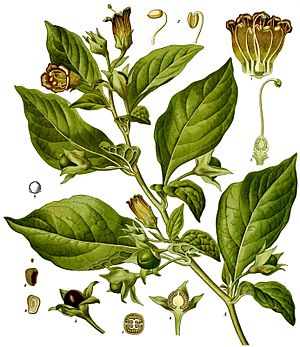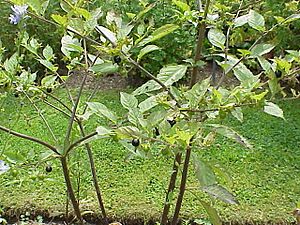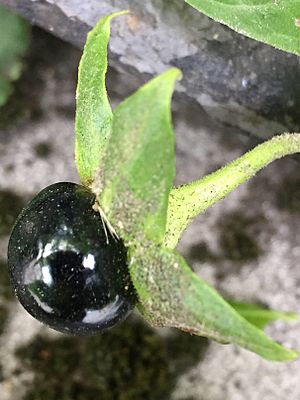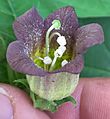Belladonna facts for kids
Quick facts for kids Belladonna |
|
|---|---|
 |
|
| Drawing from Köhler's Medicinal Plants (1887) | |
| Scientific classification | |
| Genus: |
Atropa
|
| Species: |
belladonna
|
Atropa belladonna, often called belladonna or deadly nightshade, is a very poisonous plant. It's a perennial herbaceous plant, meaning it lives for more than two years and has soft stems. It belongs to the nightshade family (Solanaceae), which also includes common foods like tomatoes, potatoes, and eggplants.
This plant is originally from Europe, North Africa, and Western Asia. You can find it from Great Britain all the way to western Ukraine and Iran. It has also spread to parts of Canada and the United States.
All parts of the plant, especially its leaves and shiny black berries, are extremely toxic if eaten. They contain powerful chemicals called tropane alkaloids, such as atropine and scopolamine. These chemicals can cause strange effects like delirium (being confused and restless) and hallucinations (seeing or hearing things that aren't there). They are also used in some medicines. Because of its unpredictable and dangerous effects, belladonna poisoning needs quick medical help. The antidote for belladonna poisoning is a medicine called physostigmine or pilocarpine.
Contents
History of Deadly Nightshade
Atropa belladonna has a long and interesting history. People have used it as a medicine, a cosmetic, and a poison for thousands of years.
Naming the Plant
The famous scientist Carl Linnaeus (1707–1778) gave the plant its scientific name, Atropa belladonna, when he created his system for classifying living things. He chose the name Atropa because of the plant's poisonous nature. In ancient Greek stories, Atropos was one of the Three Fates who decided how long a person would live. She was the one who cut the "thread of life," ending it.
Linnaeus chose the species name belladonna because it means "beautiful woman" in Italian. During the Renaissance (a period in European history from the 14th to the 17th century), women would use the juice from the berries in their eyedrops. This made their pupils (the black centers of their eyes) get bigger, which was thought to make their eyes look more attractive.
Ancient Uses
People have known about the effects of nightshade plants since at least the 4th century BC. Ancient Greek thinkers like Theophrastus suggested using plants like mandrake (another nightshade) for treating wounds, pain, and trouble sleeping.
Around the first century BC, the Egyptian queen Cleopatra reportedly used extracts from the henbane plant (also a nightshade) to make her pupils larger, just like the Renaissance women.
The Romans also knew about deadly nightshades as a poison. There were rumors that the Roman empress Livia Drusilla used the juice of Atropa belladonna berries to poison her husband, Emperor Augustus.
In the first century A.D., a doctor named Pedanius Dioscorides wrote about using mandrake wine as an anesthetic (something to stop pain) before surgery. This use of nightshade plants for pain relief continued through the Roman and Islamic Empires and in Europe until modern anesthetics were developed in the 1800s.
Modern Discoveries
The scientific study of Atropa belladonna began in the 1800s. In 1831, a German pharmacist named Heinrich F. G. Mein successfully created a pure, crystal form of the plant's active chemical, which he named atropine.
What Deadly Nightshade Looks Like
Atropa belladonna is a plant that grows from a thick root. It can grow quite tall, up to about 6.5 feet (2 meters). Its leaves are oval-shaped and can be up to 7 inches (18 cm) long.
The plant has bell-shaped flowers that are a dull purple color with hints of green. They have a faint smell. The fruits are berries that start green and turn a shiny black when they are ripe. They are about 0.6 inches (1.5 cm) wide. These berries look sweet and are eaten by animals, which helps spread the plant's seeds. However, the berries are very toxic to humans.
There is also a rare type of belladonna called Atropa belladonna var. lutea that has pale yellow flowers and pale yellow berries.
Deadly Nightshade vs. Black Nightshade
Sometimes, Atropa belladonna is confused with the much less poisonous black nightshade (Solanum nigrum). Both are in the nightshade family, but they are different plants.
Here's how to tell them apart:
- Deadly nightshade berries grow one by one. Black nightshade berries grow in bunches.
- Deadly nightshade flowers are dull purple. Black nightshade flowers have white petals.
Where Deadly Nightshade Grows
Atropa belladonna naturally grows in cool parts of southern, Central, and Eastern Europe, as well as in North Africa, Turkey, Iran, and the Caucasus mountains.
However, people have grown it for its medicinal uses, and it has spread beyond its original home. In Britain, it grows naturally in places with limestone soil, like disturbed ground, field edges, and open woodlands. Birds help spread its seeds.
It has also become a wild plant in parts of North America. There, it often grows in shady, moist areas with soil rich in limestone. In some places, it's considered a weed because it can easily grow in areas where the soil has been disturbed.
Growing Deadly Nightshade
Atropa belladonna is not usually grown in gardens because it is so poisonous. When it is grown, it's usually for its tall, upright shape and its noticeable berries.
It can be tricky to grow from seeds because the seeds have hard coats that make them stay dormant (asleep) for a long time. It can take several weeks for them to sprout. The young plants need very clean soil to prevent them from getting sick, and they don't like their roots to be disturbed when they are moved.
Deadly Nightshade's Family Tree
Atropa belladonna is part of the nightshade family (Solanaceae). This family includes many well-known plants like potatoes, tomatoes, eggplants, jimsonweed, tobacco, wolfberry, and chili peppers.
This plant has many common names, including belladonna, deadly nightshade, divale, dwale, banewort, devil's berries, death cherries, beautiful death, devil's herb, great morel, and dwayberry.
Why Deadly Nightshade is So Toxic
Belladonna is one of the most toxic plants known. Eating it can be very dangerous for people, especially those with certain health conditions. All parts of the plant contain poisonous chemicals called tropane alkaloids.
The roots are usually the most poisonous part, but the amount of poison can change from one plant to another. The leaves have the most poison when the plant is budding and flowering. Even honey made by bees from belladonna flowers can contain these toxic chemicals.
The berries are the most dangerous part for children. They look attractive, like cherries, and have a slightly sweet taste, which can tempt kids to eat them.
The main chemicals in belladonna are atropine, scopolamine, and hyoscyamine. These chemicals affect the body's nervous system. If someone is poisoned by belladonna, they might have:
- Large pupils (the black part of the eye)
- Sensitivity to light
- Blurred vision
- A fast heart rate (tachycardia)
- Loss of balance
- Headaches
- A rash and flushed skin
- A very dry mouth and throat
- Slurred speech
- Trouble going to the bathroom
- Confusion, hallucinations, and delirium
- Seizures
In 2009, an adult woman accidentally ate six belladonna berries, thinking they were blueberries. This led to severe poisoning. The plant's deadly effects happen because atropine stops the nervous system from controlling important body functions like sweating, breathing, and heart rate.
If someone is poisoned by belladonna, doctors can give them an antidote like physostigmine or pilocarpine.
Atropa belladonna is also poisonous to many farm animals, causing them to become paralyzed. However, some animals, like cattle and rabbits, can eat the plant without getting sick. In humans, these chemicals can also affect thinking, memory, and learning.
Gallery
Images for kids
-
A belladonna plaster, found at the Hunterian Museum in Glasgow.
See also
 In Spanish: Belladonna (desambiguación) para niños
In Spanish: Belladonna (desambiguación) para niños


















